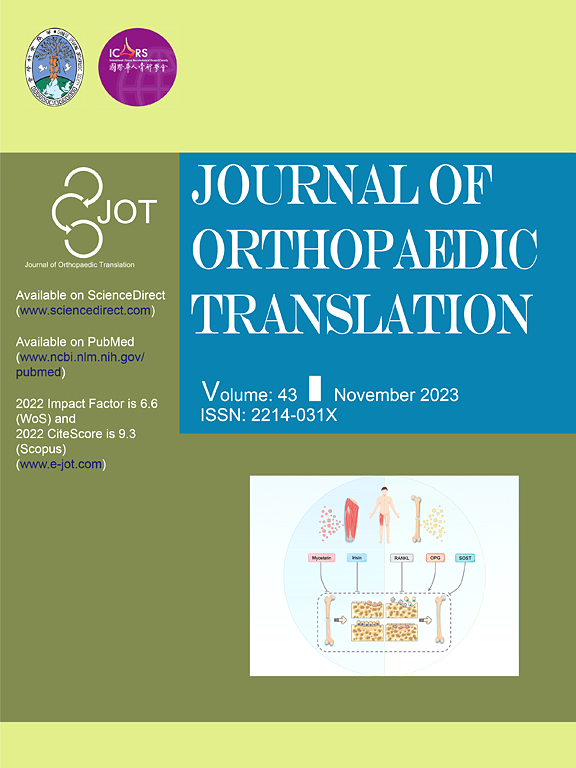GPX4激活剂增强脊髓损伤的神经保护和功能恢复
IF 5.9
1区 医学
Q1 ORTHOPEDICS
引用次数: 0
摘要
背景脊髓损伤(SCI)对个人和医疗保健系统产生严重的身体、社会和经济影响。虽然在了解脊髓损伤的病理生理方面取得了很大进展,但对铁下垂的主要调节因子GPX4(谷胱甘肽过氧化物酶4)的调节仍然知之甚少。方法采用western blot和免疫荧光法检测大鼠T10挫伤性脊髓损伤模型中GPX4的表达。使用GPX4抑制剂RSL3诱导原代神经元铁下垂,并测量炎症细胞因子的释放。将这些神经元的条件介质应用于小胶质细胞以评估激活情况。给脊髓损伤大鼠注射GPX4激活剂PKUMDL-LC-102,通过行为测试、MRI和运动诱发电位评估功能恢复情况。结果我们首先发现脊髓损伤后神经元中GPX4水平在时间和空间上下降。然后,我们证明GPX4抑制导致原发性神经元铁下垂,触发激活小胶质细胞的促炎细胞因子的分泌。本研究首次在体内对gpx4特异性靶向激活进行了研究,证明了gpx4通过改善神经元存活和减少小胶质细胞增生来促进挫伤性脊髓损伤的功能恢复。结论提示GPX4在脊髓神经保护中起关键作用。我们确定了GPX4在脊髓损伤中的关键作用,并通过特异性激活GPX4来实现神经保护,以促进体内功能恢复。这些发现为通过GPX4靶向激活促进脊髓损伤后功能恢复的治疗干预提供了一条新的途径。本文章由计算机程序翻译,如有差异,请以英文原文为准。

GPX4 activator enhances neuroprotection and functional recovery in spinal cord injury
Background
Spinal cord injury (SCI) exerts severe physical, social, and economic effects on individuals and the healthcare system. While much progress has been made in understanding the pathophysiology of SCI, the regulation of the ferroptosis master regulator, GPX4 (Glutathione Peroxidase 4), remains poorly understood.
Methods
In a rat T10 contusion SCI model, GPX4 expression was tracked with western blot and immunofluorescence. Ferroptosis was induced in primary neurons using the GPX4 inhibitor RSL3, and inflammatory cytokine release was measured. Conditioned media from these neurons was applied to microglia to assess activation. The GPX4 activator PKUMDL-LC-102 was administered to SCI rats, with functional recovery evaluated through behavioral tests, MRI, and motor-evoked potentials.
Results
We first reveal a temporal and spatial decrease of GPX4 levels in neurons after SCI. We then demonstrate that GPX4 inhibition leads to primary neuronal ferroptosis, triggering the secretion of pro-inflammatory cytokines that activate microglia. This study represents the initial in vivo investigation of GPX4-specific targeted activation, demonstrating its potential to promote functional recovery in contusive SCI by improving neuronal survival and reducing microgliosis.
Conclusion
These findings highlight the significance of GPX4 as a key factor for neuroprotection in the spinal cord. We identified the pivotal role of GPX4 in SCI and realize the neuroprotection via specific GPX4 activation to improve functional recovery in vivo.
The translational potential of this article
These findings provide a novel avenue for therapeutic intervention to enhance functional recovery after SCI through GPX4 targeted activation.
求助全文
通过发布文献求助,成功后即可免费获取论文全文。
去求助
来源期刊

Journal of Orthopaedic Translation
Medicine-Orthopedics and Sports Medicine
CiteScore
11.80
自引率
13.60%
发文量
91
审稿时长
29 days
期刊介绍:
The Journal of Orthopaedic Translation (JOT) is the official peer-reviewed, open access journal of the Chinese Speaking Orthopaedic Society (CSOS) and the International Chinese Musculoskeletal Research Society (ICMRS). It is published quarterly, in January, April, July and October, by Elsevier.
 求助内容:
求助内容: 应助结果提醒方式:
应助结果提醒方式:


